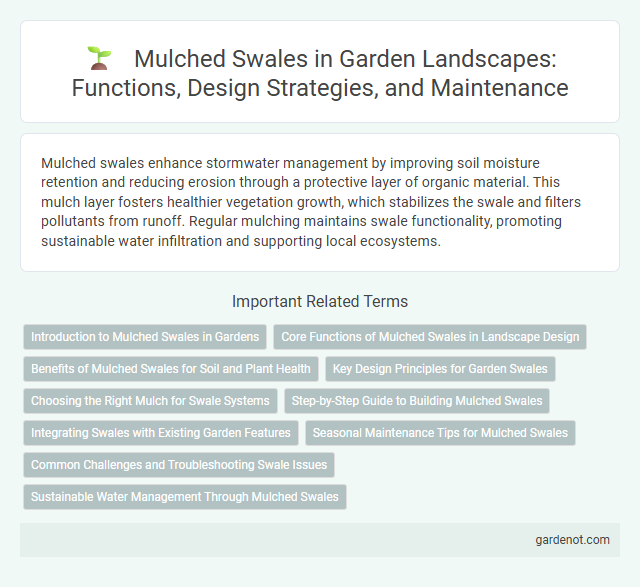Mulched swales enhance stormwater management by improving soil moisture retention and reducing erosion through a protective layer of organic material. This mulch layer fosters healthier vegetation growth, which stabilizes the swale and filters pollutants from runoff. Regular mulching maintains swale functionality, promoting sustainable water infiltration and supporting local ecosystems.
Introduction to Mulched Swales in Gardens
Mulched swales in gardens enhance water retention by combining shallow trenches with organic mulch to slow runoff and promote infiltration. This sustainable landscaping technique improves soil moisture, supports plant health, and reduces erosion by capturing and gradually releasing rainwater. Implementing mulched swales optimizes garden irrigation while fostering a resilient ecosystem that efficiently manages stormwater.
Core Functions of Mulched Swales in Landscape Design
Mulched swales enhance stormwater management by promoting infiltration, reducing surface runoff, and filtering pollutants through organic mulch layers. These swales support soil moisture retention and improve groundwater recharge, aiding in sustainable landscape design. Their core function also includes stabilizing soil, preventing erosion, and creating microhabitats for beneficial microorganisms and plants.
Benefits of Mulched Swales for Soil and Plant Health
Mulched swales improve soil structure by enhancing moisture retention and reducing erosion, which promotes healthier root development. The organic mulch decomposes over time, enriching the soil with essential nutrients and supporting beneficial microbial activity. This combination of improved soil conditions and increased nutrient availability fosters robust plant growth and resilience.
Key Design Principles for Garden Swales
Mulched swales incorporate organic mulch layers that enhance soil moisture retention, prevent erosion, and promote healthy plant growth in garden swales. Key design principles include ensuring a gentle swale slope of 1-5%, selecting mulch types that decompose slowly to maintain structure, and designing swales to capture and infiltrate runoff effectively. Proper layering with mulch, native plants, and graded soil maximizes water absorption and supports sustainable landscape management.
Choosing the Right Mulch for Swale Systems
Choosing the right mulch for swale systems significantly enhances water retention, soil moisture regulation, and erosion control. Organic mulches like wood chips or straw promote microbial activity and nutrient cycling, improving soil structure in swales. Inorganic options such as gravel reduce weed growth and increase durability, making them ideal for swales in arid or high-traffic areas.
Step-by-Step Guide to Building Mulched Swales
Mulched swales are landscape features designed to capture and infiltrate stormwater, reducing runoff and promoting soil moisture retention. Begin by marking the contour line, then excavate a shallow trench following this line, ensuring gentle slopes for water distribution. Next, backfill the trench with a 3-6 inch layer of organic mulch, such as wood chips or straw, to enhance water absorption and suppress weeds, completing the swale installation for sustainable water management.
Integrating Swales with Existing Garden Features
Mulched swales enhance water retention by combining soil berms with organic mulch layers that improve soil moisture and nutrient levels. Integrating swales with existing garden features such as flower beds, shrubs, and pathways creates seamless water management while supporting plant health and preventing erosion. Proper positioning of mulched swales around trees and garden borders maximizes runoff absorption and reduces maintenance requirements.
Seasonal Maintenance Tips for Mulched Swales
Mulched swales require regular seasonal maintenance to ensure optimal water absorption and prevent erosion. During spring and fall, inspect mulch layers for compaction or displacement and replenish mulch to maintain a 3-4 inch depth, promoting soil moisture retention and weed suppression. Clearing debris and monitoring swale vegetation health throughout the year supports effective stormwater management and prolongs swale functionality.
Common Challenges and Troubleshooting Swale Issues
Mulched swales often face challenges such as mulch displacement, compaction, and uneven decomposition that can reduce water infiltration and soil health. Poor mulch management can lead to clogging, which hinders the swale's ability to capture runoff effectively, causing localized erosion and water pooling. Regular monitoring, proper mulch selection, and timely replenishment are essential strategies to prevent swale failure and maintain optimal stormwater management performance.
Sustainable Water Management Through Mulched Swales
Mulched swales enhance sustainable water management by increasing infiltration rates and reducing surface runoff through the organic mulch layer, which improves soil moisture retention and soil health. The mulch acts as a natural filter, trapping sediments and pollutants, thereby improving water quality before it recharges groundwater or enters receiving waters. These swales also support vegetation growth, stabilizing the soil and promoting evapotranspiration for balanced hydrological cycles.
Mulched swale Infographic

 gardenot.com
gardenot.com